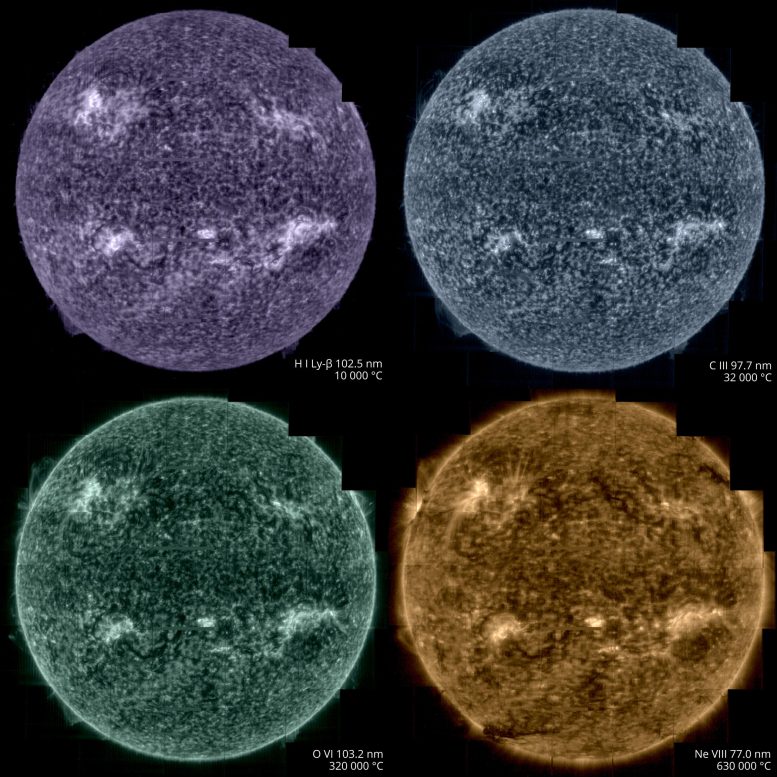
Animation του Solar Orbiter της Ευρωπαϊκής Διαστημικής Υπηρεσίας. Πίστωση: ESA/Medialab
Οι τελευταίες εικόνες του Solar Orbiter δείχνουν τον πλήρη ήλιο με άνευ προηγουμένου λεπτομέρεια. Τραβήχτηκε στις 7 Μαρτίου 2022, όταν το διαστημόπλοιο περνούσε απευθείας μεταξύ της Γης και του Ήλιου.
Μία από τις εικόνες που τραβήχτηκαν από το Extreme Ultraviolet Imager (EUI) είναι η εικόνα της υψηλότερης ανάλυσης του δίσκου του πλήρους ήλιου και της εξωτερικής ατμόσφαιρας, η κορώνα, που τραβήχτηκε ποτέ.
Μια άλλη εικόνα που λήφθηκε από το όργανο Spectral Imaging of the Coronal Environment (SPICE) αντιπροσωπεύει την πρώτη πλήρη εικόνα του Ήλιου σε 50 χρόνια και την καλύτερη εικόνα που λήφθηκε κατά μήκος του μήκους κύματος βήτα Lyman της υπεριώδους ακτινοβολίας που εκπέμπεται από το αέριο υδρογόνο.
Οι εικόνες τραβήχτηκαν όταν το ηλιακό τροχιακό ήταν περίπου 75 εκατομμύρια χιλιόμετρα μακριά, στα μισά του δρόμου μεταξύ του κόσμου μας και του μητρικού του αστέρα. Το τηλεσκόπιο υψηλής ανάλυσης του EUI καταγράφει εικόνες με τόσο υψηλή χωρική ανάλυση που, σε αυτή την κοντινή απόσταση, απαιτείται ένα μωσαϊκό 25 μεμονωμένων εικόνων για να καλύψει ολόκληρο τον Ήλιο. Τραβηγμένη μία προς μία, η πλήρης εικόνα τραβήχτηκε σε διάστημα άνω των τεσσάρων ωρών, επειδή κάθε κομμάτι διαρκεί περίπου 10 λεπτά, συμπεριλαμβανομένου του χρόνου που χρειάζεται το διαστημόπλοιο για να δείξει από το ένα μέρος στο άλλο.

Ο Ήλιος όπως φαίνεται από το Solar Orbiter σε ακραίο υπεριώδες φως από απόσταση περίπου 75 εκατομμυρίων km. Η εικόνα είναι ένα μωσαϊκό 25 μεμονωμένων εικόνων που τραβήχτηκαν στις 7 Μαρτίου 2022 από το τηλεσκόπιο υψηλής ανάλυσης Ultraviolet Imaging Instrument (EUI). Αυτή η εικόνα τραβήχτηκε σε μήκος κύματος 17 νανόμετρων, στην ακραία υπεριώδη περιοχή του ηλεκτρομαγνητικού φάσματος, αποκαλύπτοντας την ανώτερη ατμόσφαιρα του ήλιου, την κορώνα, η οποία έχει θερμοκρασία περίπου ενός εκατομμυρίου βαθμών Κελσίου. Περιλαμβάνεται επίσης μια εικόνα της κλίμακας από τη Γη στη θέση 2. Πιστώσεις: ESA και NASA/Solar Orbiter/EUI Ομάδα. Επεξεργασία δεδομένων: E. Kraaikamp (ROB)
Συνολικά, το τελική εικόνα Περιέχει περισσότερα από 83 εκατομμύρια pixel σε ένα πλέγμα 9148 x 9112 pixel. Για σύγκριση, αυτή η εικόνα έχει ανάλυση δέκα φορές καλύτερη από αυτή που μπορεί να εμφανίσει μια οθόνη τηλεόρασης 4K.
Το EUI απεικονίζει τον Ήλιο σε μήκος κύματος 17 νανόμετρων, στην ακραία υπεριώδη περιοχή του ηλεκτρομαγνητικού φάσματος. Αυτό αποκαλύπτει την ανώτερη ατμόσφαιρα του ήλιου, το στέμμα, το οποίο έχει θερμοκρασία περίπου ένα εκατομμύριο βαθμούς[{” attribute=””>Celsius.

Solar Orbiter took images of the Sun on March 7, from a distance of roughly 75 million kilometres, using its Spectral Imaging of the Coronal Environment (SPICE) instrument. SPICE takes simultaneous “spectral images” at several different wavelengths of the extreme ultraviolet spectrum by scanning its spectrometer slit across a region on the Sun. The different wavelengths recorded correspond to different layers in the Sun’s lower atmosphere. Purple corresponds to hydrogen gas at a temperature of 10,000°C, blue to carbon at 32,000°C, green to oxygen at 320,000°C, yellow to neon at 630,000°C. Each full-Sun image is made up of a mosaic of 25 individual scans. It represents the best full Sun image taken at the Lyman beta wavelength of ultraviolet light that is emitted by hydrogen gas. Credit: ESA & NASA/Solar Orbiter/SPICE team; Data processing: G. Pelouze (IAS)
At the 2 o’clock (near the image of the Earth for scale) and 8 o’clock positions on the edges of the Sun, dark filaments can be seen projecting away from the surface. These ‘prominences’ are prone to erupt, throwing huge quantities of coronal gas into space and creating ‘space weather’ storms.
In addition to EUI, the SPICE instrument was also recording data during the crossing. These too needed to be pieced together as a mosaic.
SPICE is designed to trace the layers in the Sun’s atmosphere from the corona, down to a layer known as the chromosphere, getting closer to the surface. The instrument does this by looking at the different wavelengths of extreme ultraviolet light that come from different atoms.

Taking the Sun’s temperature. Credit: ESA & NASA/Solar Orbiter/SPICE team; Data processing: G. Pelouze (IAS)
In the SPICE sequence of images purple corresponds to hydrogen gas at a temperature of 10,000°C, blue to carbon at 32,000°C, green to oxygen at 320,000°C, yellow to neon at 630,000°C.
This will allow solar physicists to trace the extraordinarily powerful eruptions that take place in the corona down through the lower atmospheric layers. It will also allow them to study one of the most puzzling observations about the Sun: how the temperature is rising through the ascending atmospheric layers.
Usually the temperature drops as you move away from a hot object. But above the Sun, the corona reaches a million degrees Celsius whereas the surface is only about 5000°C. Investigating this mystery is one of the key scientific objectives of Solar Orbiter.
The images were taken on 7 March, precisely when Solar Orbiter crossed the Sun-Earth line, so the images can be compared with Earth-bound solar instruments and cross-calibrated. This will make it easier to compare results from different instruments and observatories in future.
On March 26, Solar Orbiter reaches another mission milestone: its first close perihelion. The spacecraft is now inside the orbit of Mercury, the inner planet, taking the highest resolution images of the Sun it can take. It is also recording data on the solar wind of particles that flows outwards from the Sun.
And this is just the start, over the coming years the spacecraft will repeatedly fly this close to the Sun. It will also gradually raise its orientation to view the Sun’s previously unobserved polar regions.
Solar Orbiter is a space mission of international collaboration between ESA and NASA.

“Ερασιτέχνης διοργανωτής. Εξαιρετικά ταπεινός web maven. Ειδικός κοινωνικών μέσων Wannabe. Δημιουργός. Thinker.”

